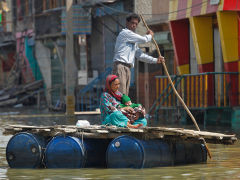Islamabad, Pakistan – For the second time in three years, catastrophic monsoon floods have carved a path of destruction across Pakistan’s north and central regions, particularly in its Punjab province, submerging villages, drowning farmland, displacing millions and killing hundreds.
This year, India – Pakistan’s archrival and a nuclear-armed neighbour – is also reeling. Its northern states, including Himachal Pradesh, Uttarakhand and Indian Punjab, have seen widespread flooding as heavy monsoon rains swell rivers on both sides of the border.
Recommended Stories
list of 4 items
- list 1 of 4Behind Pakistan’s repeated floods: Melting glaciers, depleted forests
- list 2 of 4Can India stop Pakistan’s river water — and will it spark a new war?
- list 3 of 4Photos: Half a million flood-hit people evacuated in eastern Pakistan
- list 4 of 4Flood threat rises as rain lashes India and Pakistan
end of list
Pakistani authorities say that since late June, when the monsoon season began, at least 884 people have died nationally, more than 220 of them in Punjab. On the Indian side, the casualty count has crossed 100, with more than 30 dead in Indian Punjab.
Yet, shared suffering hasn’t brought the neighbours closer: In Pakistan’s Punjab, which borders India, federal minister Ahsan Iqbal has, in fact, accused New Delhi of deliberately releasing excess water from dams without timely warnings.
“India has started using water as a weapon and has caused wide-scale flooding in Punjab,” Iqbal said last month, citing releases into the Ravi, Sutlej and Chenab rivers, all of which originate in Indian territory and flow into Pakistan.
Iqbal further said that releasing flood water was the “worst example of water aggression” by India, which he said threatened lives, property and livelihoods.
“Some issues should be beyond politics, and water cooperation must be one of them,” the minister said on August 27, while he participated in rescue efforts in Narowal city, his constituency that borders India.
Those accusations come amid heightened tensions between India and Pakistan, and the breakdown of a six-decade-old pact that helped them share waters for rivers that are lifelines to both nations.
But experts argue that the evidence is thin to suggest that India might have deliberately sought to flood Pakistan – and the larger nation’s own woes point to the risks of such a strategy, even if New Delhi were to contemplate it.
Weaponising water

Relations between India and Pakistan, already at a historic low, plummeted further in April after the Pahalgam attack, in which gunmen killed 26 civilians in Indian-administered Kashmir. India blamed Pakistan for the attack and walked out of the Indus Waters Treaty (IWT), the transboundary agreement that governs the Indus Basin’s six rivers.
Pakistan rejected the accusation that it was in any way behind the Pahalgam attack. But in early May, the neighbours waged a four-day conflict, targeting each other’s military bases with missiles and drones in the gravest military escalation between them in almost three decades.
Under the IWT, the two countries were required to exchange detailed water-flow data regularly. With India no longer adhering to the pact, fears have mounted in recent months that New Delhi could either try to stop the flow of water into Pakistan, or flood its western neighbour through sudden, large releases.
After New Delhi suspended its participation in the IWT, India’s Home Minister Amit Shah in June said the treaty would never be restored, a stance that prompted protests in Pakistan and accusations of “water terrorism”.
But while the Indian government has not issued a formal response to accusations that it has chosen to flood Pakistan, the Indian High Commission in Islamabad has, in the last two weeks, shared several warnings of possible cross-border flooding on “humanitarian grounds”.
And water experts say that attributing Pakistan’s floods primarily to Indian water releases from dams is an “oversimplification” of the causes of the crisis that risks obscuring the urgent, shared challenges posed by climate change and ageing infrastructure.
“The Indian decision to release water from their dam has not caused flooding in Pakistan,” said Daanish Mustafa, a professor of critical geography at King’s College London.
“India has major dams on its rivers, which eventually make their way to Pakistan. Any excess water that will be released from these rivers will significantly impact India’s own states first,” he told Al Jazeera.
Both Pakistan and India depend on glaciers in the Himalayan and Karakoram ranges to feed their rivers. For Pakistan, the Indus river basin is a lifeline. It supplies water to most of the country’s roughly 250 million people and underpins its agriculture.

Under the





